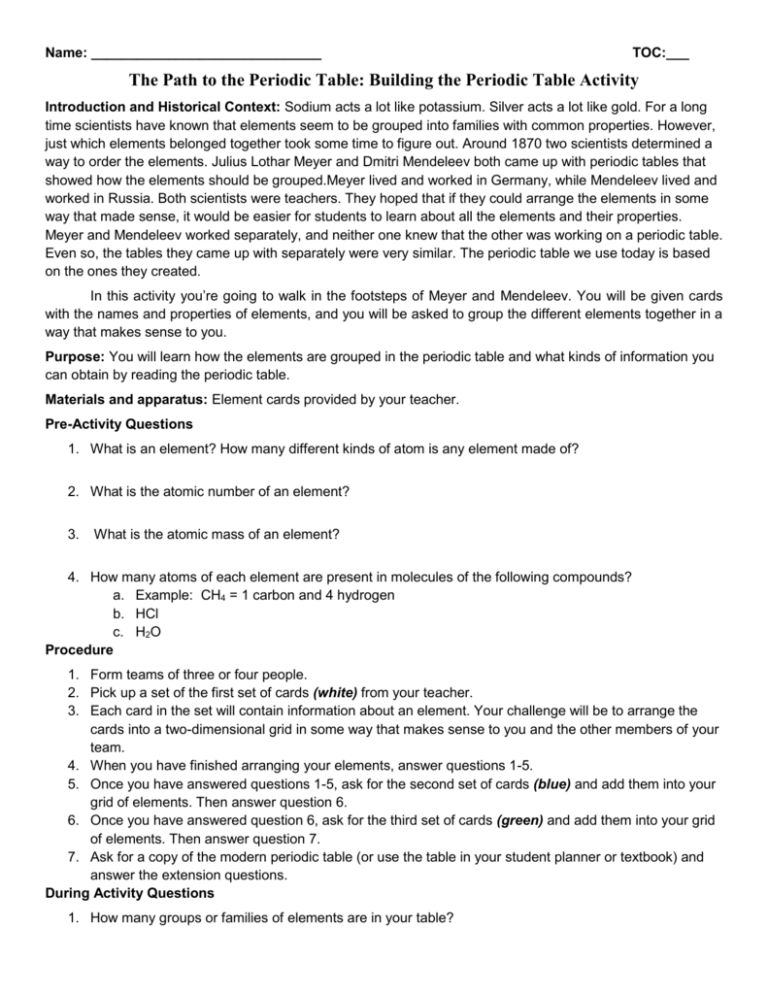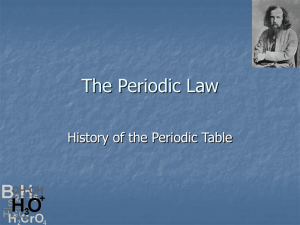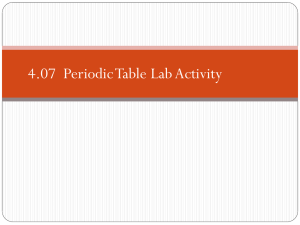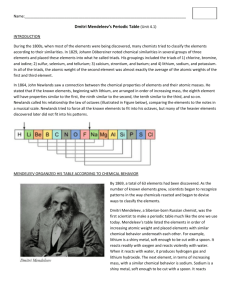Path to the Periodic Table activity
advertisement

Name: ______________________________ TOC:___ The Path to the Periodic Table: Building the Periodic Table Activity Introduction and Historical Context: Sodium acts a lot like potassium. Silver acts a lot like gold. For a long time scientists have known that elements seem to be grouped into families with common properties. However, just which elements belonged together took some time to figure out. Around 1870 two scientists determined a way to order the elements. Julius Lothar Meyer and Dmitri Mendeleev both came up with periodic tables that showed how the elements should be grouped.Meyer lived and worked in Germany, while Mendeleev lived and worked in Russia. Both scientists were teachers. They hoped that if they could arrange the elements in some way that made sense, it would be easier for students to learn about all the elements and their properties. Meyer and Mendeleev worked separately, and neither one knew that the other was working on a periodic table. Even so, the tables they came up with separately were very similar. The periodic table we use today is based on the ones they created. In this activity you’re going to walk in the footsteps of Meyer and Mendeleev. You will be given cards with the names and properties of elements, and you will be asked to group the different elements together in a way that makes sense to you. Purpose: You will learn how the elements are grouped in the periodic table and what kinds of information you can obtain by reading the periodic table. Materials and apparatus: Element cards provided by your teacher. Pre-Activity Questions 1. What is an element? How many different kinds of atom is any element made of? 2. What is the atomic number of an element? 3. What is the atomic mass of an element? 4. How many atoms of each element are present in molecules of the following compounds? a. Example: CH4 = 1 carbon and 4 hydrogen b. HCl c. H2O Procedure 1. Form teams of three or four people. 2. Pick up a set of the first set of cards (white) from your teacher. 3. Each card in the set will contain information about an element. Your challenge will be to arrange the cards into a two-dimensional grid in some way that makes sense to you and the other members of your team. 4. When you have finished arranging your elements, answer questions 1-5. 5. Once you have answered questions 1-5, ask for the second set of cards (blue) and add them into your grid of elements. Then answer question 6. 6. Once you have answered question 6, ask for the third set of cards (green) and add them into your grid of elements. Then answer question 7. 7. Ask for a copy of the modern periodic table (or use the table in your student planner or textbook) and answer the extension questions. During Activity Questions 1. How many groups or families of elements are in your table? 2. What criteria did you use to choose which group or family an element belongs to? 3. Is there a trend in atomic mass going across your table? Is there a trend in atomic mass going from top to bottom? 4. Are there any exceptions to these trends? If so, which elements break the trend? Why did you arrange these elements the way you did? 5. Are there any holes or gaps in your arrangement? Where are they? What do you think these gaps might mean? 6. How did you fit in the second set of cards? Was it easy to do? Why do you think it was easy or hard? 7. How did you fit in the third set of cards? Was it easy to do? Why do you think it was easy or hard? Post Activity Questions 8. After you prepared your periodic tables, your teacher gave you additional sets of cards to fit into your tables. How did your table change each time you added new elements to your table? 9. How is your table similar to a modern periodic table? How is yours different? 10. How do we explain today the fact that tellurium comes before iodine in the periodic table, even though tellurium has a higher atomic mass than iodine? 11. Mendeleev predicted the existence of gallium and germanium because of the holes in his periodic table. Why do you think Mendeleev did not predict the existence of the noble gases? 12. Look at a modern periodic table. Suppose two new elements were discovered with the atomic numbers 120 and 121. Where in the periodic table do you think we would place these new elements? 13. Suppose a new element X is discovered. It forms a compound with chlorine, and the formula of this compound is XCl4. What group or family do you think this element would belong to? 14. Find the element barium (Ba) on a modern periodic table. What group or family is barium in? What do you think the formula of a compound of barium and chlorine would be? © 2008 Chemical Heritage Foundation http://www.chemheritage.org








